英语语法反意疑问句.ppt
合集下载
高考英语语法——反意疑问句(共11张PPT)
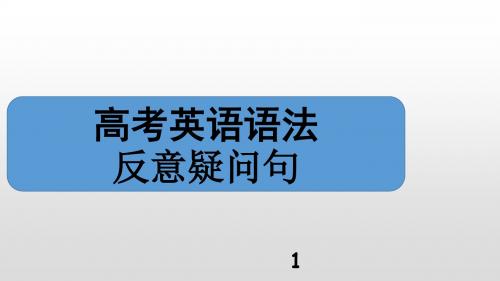
9
当陈述句部分含有主从复合句时,附加部分的代词和助动词 须与主句中的主谓保持一致。
You needn't do it since he has finished it, need you? It's the second time that you have sung that song, isn't it?
ome, shall we?
Let us go home, will you?
Open the door, will you?
5
need和dare既可以用作情态动词,又可以用作行为动词,所以在反意疑 问句中要准确判断其是情态动词还是行为动词。
He needn’t do it again, need he? He doesn’t need to do it again, does he? She dare say it, daren’t she? She doesn’t dare to say it, does she?
2
构成
The car is your father's, The girl doesn't sleep, The doctor can help you,
陈述句
isn't it? does she? can't he?
反意疑问句
be动词/情态动词/助动词 (not)+主语(代词)
3
前肯后否 前否后肯
He thinks that it will rain tomorrow, doesn't he? I think that it will rain tomorrow, won't it? They don't suppose that the film is moving, do they?
当陈述句部分含有主从复合句时,附加部分的代词和助动词 须与主句中的主谓保持一致。
You needn't do it since he has finished it, need you? It's the second time that you have sung that song, isn't it?
ome, shall we?
Let us go home, will you?
Open the door, will you?
5
need和dare既可以用作情态动词,又可以用作行为动词,所以在反意疑 问句中要准确判断其是情态动词还是行为动词。
He needn’t do it again, need he? He doesn’t need to do it again, does he? She dare say it, daren’t she? She doesn’t dare to say it, does she?
2
构成
The car is your father's, The girl doesn't sleep, The doctor can help you,
陈述句
isn't it? does she? can't he?
反意疑问句
be动词/情态动词/助动词 (not)+主语(代词)
3
前肯后否 前否后肯
He thinks that it will rain tomorrow, doesn't he? I think that it will rain tomorrow, won't it? They don't suppose that the film is moving, do they?
反义疑问句(共14张PPT)
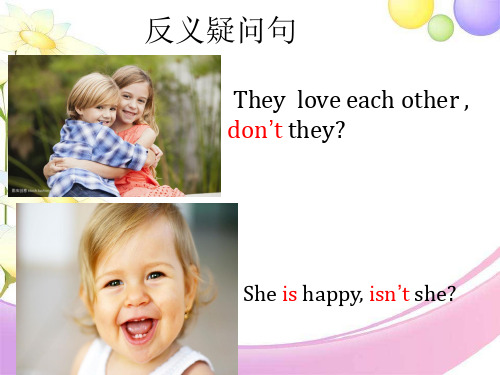
+ You have to believe in yourself. That's the secret of success. 人必须相信自己,这是成功的秘诀。
+
特殊用法2-----There be 句型
陈述部分是“there be”结构时,疑问部分用be there。
There is something wrong with your watch, isn't there?
Summary
一、反义疑问句的结构: 前肯+后否 ;前否+后肯
二、反义疑问句的四种特殊用法 1、祈使句的反义疑问句 2、There be 句型的反义疑问句 3、陈述部分有hardly等词时,提问用肯定形式。 4、反义疑问句的回答(根据事实)
Thanks for listening! Goodbye!
Chinese,_c_a_n___h_e___? 6.Please call me,_w__o_n_’t_y_o_u__?
7.Let’s go home, s_h__a_l_l_w__e__ ?
8.Let us go home,w__i_l_l_y_o__u__?
9.Don’t play on the road,w__i_l_l_y__o_u_?
2、Let‘s 开头的祈使句,后用shall we? 而Let us 开 头的祈使句,后用will you ?
+9、要学生做的事,教职员躬亲共做;要学生学的知识,教职员躬亲共学;要学生守的规则,教职员躬亲共守。2024/3/72024/3/7Thursday, March 07, 2024 +10、阅读一切好书如同和过去最杰出的人谈话。2024/3/72024/3/72024/3/73/7/2024 1:35:33 PM +11、只有让学生不把全部时间都用在学习上,而留下许多自由支配的时间,他才能顺利地学习……(这)是教育过程的逻辑。2024/3/72024/3/72024/3/7Mar-247-Mar-24 +12、要记住,你不仅是教课的教师,也是学生的教育者,生活的导师和道德的引路人。2024/3/72024/3/72024/3/7Thursday, March 07, 2024
+
特殊用法2-----There be 句型
陈述部分是“there be”结构时,疑问部分用be there。
There is something wrong with your watch, isn't there?
Summary
一、反义疑问句的结构: 前肯+后否 ;前否+后肯
二、反义疑问句的四种特殊用法 1、祈使句的反义疑问句 2、There be 句型的反义疑问句 3、陈述部分有hardly等词时,提问用肯定形式。 4、反义疑问句的回答(根据事实)
Thanks for listening! Goodbye!
Chinese,_c_a_n___h_e___? 6.Please call me,_w__o_n_’t_y_o_u__?
7.Let’s go home, s_h__a_l_l_w__e__ ?
8.Let us go home,w__i_l_l_y_o__u__?
9.Don’t play on the road,w__i_l_l_y__o_u_?
2、Let‘s 开头的祈使句,后用shall we? 而Let us 开 头的祈使句,后用will you ?
+9、要学生做的事,教职员躬亲共做;要学生学的知识,教职员躬亲共学;要学生守的规则,教职员躬亲共守。2024/3/72024/3/7Thursday, March 07, 2024 +10、阅读一切好书如同和过去最杰出的人谈话。2024/3/72024/3/72024/3/73/7/2024 1:35:33 PM +11、只有让学生不把全部时间都用在学习上,而留下许多自由支配的时间,他才能顺利地学习……(这)是教育过程的逻辑。2024/3/72024/3/72024/3/7Mar-247-Mar-24 +12、要记住,你不仅是教课的教师,也是学生的教育者,生活的导师和道德的引路人。2024/3/72024/3/72024/3/7Thursday, March 07, 2024
完整反义疑问句课件

如果陈述句是肯定的,反义疑问句应该是否定的。
2 人称一致
陈述句和反义疑问句中的主语和动词人称要保持一致。,避免使用复杂的句子结构。
结束语
通过学习反义疑问句的结构和用法,我们可以更好地理解和运用这个表达方 式,提升我们的语言表达能力。
完整反义疑问句PPT课件
PPT介绍反义疑问句
什么是反义疑问句?
反义疑问句是指一种用于提问或表示疑问的句子结构,通常由一个陈述句和一个反义疑问句构成。
反义疑问句的结构
1
陈述句部分
包含陈述句的主谓宾结构
2
反义疑问句部分
由一个助动词和一个否定词构成
3
连接词
连接陈述句和反义疑问句的部分,常用的连接词包括but和yet
反义疑问句的语气和语调
语气
反义疑问句通常用于表示疑问、请求或强调某 种认可的语气。
语调
反义疑问句通常以升调结尾,以引起对方的回 答或注意。
反义疑问句的用法与例句
询问意见
这个计划听起来很好,不是吗?
表示认可
你很喜欢这部电影,对吗?
确认信息
你不会去参加聚会,对吗?
反义疑问句的注意事项
1 肯定陈述,否定反义疑问
2 人称一致
陈述句和反义疑问句中的主语和动词人称要保持一致。,避免使用复杂的句子结构。
结束语
通过学习反义疑问句的结构和用法,我们可以更好地理解和运用这个表达方 式,提升我们的语言表达能力。
完整反义疑问句PPT课件
PPT介绍反义疑问句
什么是反义疑问句?
反义疑问句是指一种用于提问或表示疑问的句子结构,通常由一个陈述句和一个反义疑问句构成。
反义疑问句的结构
1
陈述句部分
包含陈述句的主谓宾结构
2
反义疑问句部分
由一个助动词和一个否定词构成
3
连接词
连接陈述句和反义疑问句的部分,常用的连接词包括but和yet
反义疑问句的语气和语调
语气
反义疑问句通常用于表示疑问、请求或强调某 种认可的语气。
语调
反义疑问句通常以升调结尾,以引起对方的回 答或注意。
反义疑问句的用法与例句
询问意见
这个计划听起来很好,不是吗?
表示认可
你很喜欢这部电影,对吗?
确认信息
你不会去参加聚会,对吗?
反义疑问句的注意事项
1 肯定陈述,否定反义疑问
反义疑问句PPT

复合句主句为I/ we think/ believe/ suppose/ hope/ be sure时,反义疑问句的 主语谓语与宾语从 come by train, _________ usedn’t/didn’t she ? 陈述部分有used to,疑问部分可用 usedn’t,或didn’t。
Grammar
反义疑问句
Pip loves Estella, doesn’t he ? Yes, he does. Does Estella love Pip?
主句谓语 助动词\be动词\情态动词+主语
doesn’t she ? She likes the idea,_______ Tractors are working in the fields, aren’t they ? ________ He mustn’t park the car here, must he _______?
there be引导的反义 疑问句其附加疑问句 为:be/ not be+ there?
Pip told him his home was not the same with others’, didn’t he ?
复合句,反义疑问句 的主语谓语与主句的 主语谓语一致。
I didn’t think my home was the same with others’, was it ?
medical; research; knowledgeable; downstairs; burn; refuse; helpful; possibly; owner; neighbor; director; finger; photograph; energy; honest; course; expect; laboratory; cancer; consider; sight; underground; translate; provide; programming
反义疑问句详细讲解课件(PPT27张)
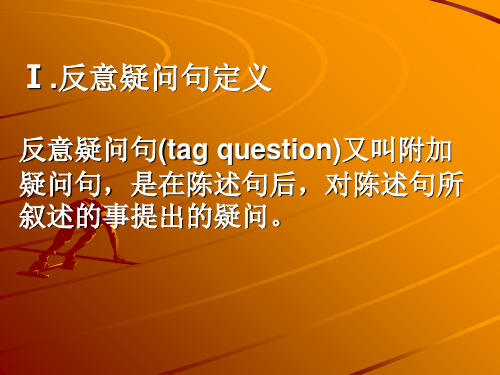
I don’t believe he has finished his work.
7.当陈述部分的主句是I think (expect, believe)等结构时,反 意疑问句的附加部分则往往与从 句中的主语和谓语动词保持对应 关系,但要注意否定的转移。 例如:
I think he’s funny, isn’t he? I don’t believe she likes my
You must have seen the film last week, didn’t you?
6. 当陈述部分是I am…时,反意疑 问句部分通常要用aren’t I;如陈述 句部分的主语是I am not时,反意疑 问句部分通常要用am I。 例如:
1)I am a teacher, aren’t I?
Ⅰ.反意疑问句定义
反意疑问句(tag question)又叫附加 疑问句,是在陈述句后,对陈述句所 叙述的事提出的疑问。
Ⅱ.基本结构:
陈述句+逗号+简短的一般疑问句?
遵循前肯定后否定前否后肯式的原则
①前肯后否式。例如:
You are all students, aren’t you﹖
②前否后肯式。例如:
Let’s have a rest, shall we? 以let us开头的祈使句,不包括 说话人在内,因此反意疑问句的 附加部分用will you。例如:
Let us stop now, will you?
Ⅳ. 反意疑问句的回答 “ 根据事实回答”
对反意疑问句的回答,无论问题的提法如何,如果 事实是肯定的,就用yes,事实是否定的,就要用no。 要特别注意陈述句部分是否定结构,反意疑问句部分 用肯定式提问时,回答yes或no与汉语正好相反。这 种省略回答的yes要译成“不”,no要译成“是”。
7.当陈述部分的主句是I think (expect, believe)等结构时,反 意疑问句的附加部分则往往与从 句中的主语和谓语动词保持对应 关系,但要注意否定的转移。 例如:
I think he’s funny, isn’t he? I don’t believe she likes my
You must have seen the film last week, didn’t you?
6. 当陈述部分是I am…时,反意疑 问句部分通常要用aren’t I;如陈述 句部分的主语是I am not时,反意疑 问句部分通常要用am I。 例如:
1)I am a teacher, aren’t I?
Ⅰ.反意疑问句定义
反意疑问句(tag question)又叫附加 疑问句,是在陈述句后,对陈述句所 叙述的事提出的疑问。
Ⅱ.基本结构:
陈述句+逗号+简短的一般疑问句?
遵循前肯定后否定前否后肯式的原则
①前肯后否式。例如:
You are all students, aren’t you﹖
②前否后肯式。例如:
Let’s have a rest, shall we? 以let us开头的祈使句,不包括 说话人在内,因此反意疑问句的 附加部分用will you。例如:
Let us stop now, will you?
Ⅳ. 反意疑问句的回答 “ 根据事实回答”
对反意疑问句的回答,无论问题的提法如何,如果 事实是肯定的,就用yes,事实是否定的,就要用no。 要特别注意陈述句部分是否定结构,反意疑问句部分 用肯定式提问时,回答yes或no与汉语正好相反。这 种省略回答的yes要译成“不”,no要译成“是”。
英语反义疑问句PPT课件

2.Let me help you , will you ?
3.Let us go home now , will you ?
4.Let’s go home now , shall we ?
.
24
(6)陈述句主语everything, something anything,nothing表物的不定代词时, 反意疑问部分主语应用it。如:
can they ?
.
19
(3)陈述句部分出现 few,little, hardly(几乎不)等,虽不是否定词,但 表示否定意义的词时,反意疑问部 分应用肯定形式。如: There is little rice in the bowl,is there? 碗里几乎没有米饭,是吗? You can hardly understand it,can you? 你几乎不能理解这一点,是吗?
.
17
(2)陈述句部分出现no, nobody, never, none,neither等 表示否定意义的词时,反意疑问部 分应用肯定形式。如: There is no rice in the bowl, is there?碗 里几乎没有米饭,是吗?
You can understand nothing, can you? 你几乎不能理解这一点,是吗?
Yes, they .are.
11
The girl is crying, isn’t she? Yes , she is .
The girl isn’t crying, is she ?
Yes , she is.
The girl isn’t laughing, is she ?
No. ,she isn’t
.
高中英语语法反义疑问句-PPT
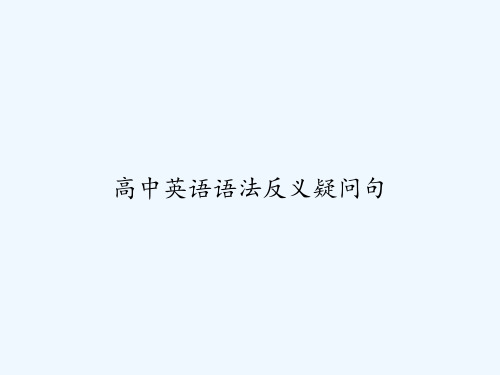
3)含有ought to 的反意疑问句, 陈述部分是肯定的,疑问部分 用oughtn't +主语。
He ought to know what to do, oughtn't he?
大家有疑问的,可以询问和交流
可以互相讨论下,
4)陈述部分有 have to + v. (had to + v.),疑问部分常用don't + 主语(didn't +主语)。
2.陈述部分为否定式 + 疑问部 分就为肯定式
You didn’t go, did you?
He can’t ride a bike, can he?
请注意以下句型的反义疑 问句:
1)陈述部分的主语是I,疑问部 分要用 aren't I.
I’m as tall as your sister, aren't I?
14)前有情态动词dare或need, 疑问部分用 need (dare ) +主语。
We need not do it again, need we ? He dare not say so, dare you?
当dare, need 为实义动词时, 疑问部分用助动词 do + 主语。
She doesn't dare to go home alone, does she?
I am a student, aren’t I?
2)陈述部分用 no, nothing, nobody, never, few, seldom, hardly, rarely, little等否定含义 的词时,疑问部分用肯定含义。
The Swede made no answer, did he / she? Some plants never blown (开花), do they ?
英语语法反义疑问句ppt

祈使句的反意疑问句
肯定的祈使句:won’t you ? / will you ? 祈使句的反意疑问句
否定的祈使句:will you ? 注:Let’s … , shall we?
Let us…, will you? e.g. Let us go to watch the movie, will you ? Let’s walk to the shops instead of taking the car, shall we ? Don't play computer games, will you?
B. is she
C. did she C. hasn’t he C. did she C. don’t they C. hasn’t she
D. wasn’t she D. doesn’t he D. didn’t she D. will they D. has she
6. There won’t be any concert this Saturday evening, C ?
A. will there not
B. will there C. is there
D. won’t there
7. He dislikes the two subjects, B he?
A. does
B. doesn’t
C. is
8. Let’s go there by bus, B ?
D. isn’t
特殊的反意疑问句
特殊的反意疑问句: (1) 主+ used to do sth, didn't/usedn't+主?
She used to get up at 7 o'clock, didn't/usedn't she ?
高考英语总复习之反义疑问句课件

?
never, seldom, hardly, few, rarely, scarcely,
little, nothing, nobody, too...to
5
2. un-, im-, in-, dis- —— 含有否定前缀的词不 属于否定词。
Your father is unhappisyn, 't he
right,
he?
16
13. wish
疑问部分要用may+主语 I wish to have a word with myoauy, I?
17
14. 并列句
并列句谓语动词根据邻近的谓语而定。
We must start at once or we can’t go therecan
on time,
19
注意:主句主语是第一人称,谓语动词 imagine,
believe, think, suppose, expect等,根据从句的主语、
谓语而定。
is he?
I don’t think he is a good student,
?
isn't it?
We think it is a good idea,
?
The man is dishoneisn,'t he
?
It is impossible to learn English without
rememberinisgnm'toitre words,
?
6
3. used to /ought to的反意疑问句
used to ----usedn’t /didn’t
we?
He is a teacher but his wife isn’t a teiascsheer?,
never, seldom, hardly, few, rarely, scarcely,
little, nothing, nobody, too...to
5
2. un-, im-, in-, dis- —— 含有否定前缀的词不 属于否定词。
Your father is unhappisyn, 't he
right,
he?
16
13. wish
疑问部分要用may+主语 I wish to have a word with myoauy, I?
17
14. 并列句
并列句谓语动词根据邻近的谓语而定。
We must start at once or we can’t go therecan
on time,
19
注意:主句主语是第一人称,谓语动词 imagine,
believe, think, suppose, expect等,根据从句的主语、
谓语而定。
is he?
I don’t think he is a good student,
?
isn't it?
We think it is a good idea,
?
The man is dishoneisn,'t he
?
It is impossible to learn English without
rememberinisgnm'toitre words,
?
6
3. used to /ought to的反意疑问句
used to ----usedn’t /didn’t
we?
He is a teacher but his wife isn’t a teiascsheer?,
反义疑问句的用法归纳 课件 共27张PPT

1. 基本原则:若陈述部分为祈使句,疑问部分通常用will you:
Please help us, will you? 请帮帮我们,好吗?
Come with us, will you? 同我们一起去,好吗?
Don’t forget to post the letter, will you? 请别忘了寄信。
五、陈述部分为祈使句的反意疑问句
3. 当祈使句为Let us时,若表示请求,疑问部分用will you,若表示建 议,疑问部分用 shall we:
Let us know your address, will you? 好吗?
请把你的地址告诉我们,
Let us go swimming together, shall we? 吗?
我们一起去游泳好
反义疑问句的用法归纳 课件 共27张PPT
反义疑问句的用法归纳 课件 共27张PPT
六、陈述部分为主从复合句的反意疑问句
• 1. 当陈述部分为主从复合句【主句+从句】时,疑问部分一般应与主句保 持一致:
He said that he didn’t like it, didn’t he? 它,是不是?
你不准笑,知道吗?
② 若must表示推测,疑问部分不能用must,而应根据must后的动词结 构采用相应的动词形式:
He must be tired, isn’t he?
他一定累了,是吗?
反义疑问句的用法归纳 课件 共27张PPT
反义疑问句的用法归纳 课件 共27张PPT
五、陈述部分为祈使句的反意疑问句
We need not do it again, need we ? He dare not say so, dare you? 【注】当dare, need 为实义动词时,疑问部分用助动词do + 主语。 She doesn't dare to go home alone, does she?
Please help us, will you? 请帮帮我们,好吗?
Come with us, will you? 同我们一起去,好吗?
Don’t forget to post the letter, will you? 请别忘了寄信。
五、陈述部分为祈使句的反意疑问句
3. 当祈使句为Let us时,若表示请求,疑问部分用will you,若表示建 议,疑问部分用 shall we:
Let us know your address, will you? 好吗?
请把你的地址告诉我们,
Let us go swimming together, shall we? 吗?
我们一起去游泳好
反义疑问句的用法归纳 课件 共27张PPT
反义疑问句的用法归纳 课件 共27张PPT
六、陈述部分为主从复合句的反意疑问句
• 1. 当陈述部分为主从复合句【主句+从句】时,疑问部分一般应与主句保 持一致:
He said that he didn’t like it, didn’t he? 它,是不是?
你不准笑,知道吗?
② 若must表示推测,疑问部分不能用must,而应根据must后的动词结 构采用相应的动词形式:
He must be tired, isn’t he?
他一定累了,是吗?
反义疑问句的用法归纳 课件 共27张PPT
反义疑问句的用法归纳 课件 共27张PPT
五、陈述部分为祈使句的反意疑问句
We need not do it again, need we ? He dare not say so, dare you? 【注】当dare, need 为实义动词时,疑问部分用助动词do + 主语。 She doesn't dare to go home alone, does she?
高考英语语法复习反义疑问句课件
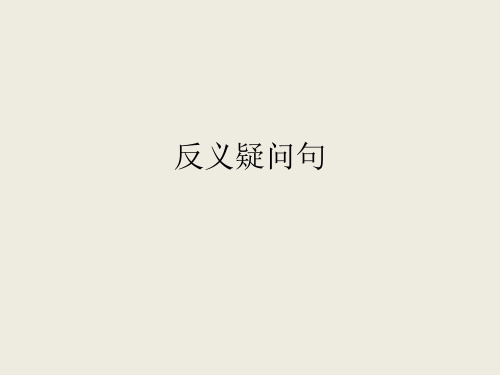
he?
• Eg:She must be looking forward to your return,___?
• A.mustn’t she B.wasn’t she C.isn’t she D.didn’t she
•C
• 三、主从复合句中和主句保持一致。但如 果
• 1.主句的主语为一人称I或we。
The Swede made no answer, did he / she? Some plants never blown (开花), do they ?
• 4) 含有ought to 的反意疑问句,陈述部分是肯定 的,疑问部分用shouldn't / oughtn't +主语。
He ought to know what to do, oughtn't he? / shouldn't he? • 5) 陈述部分有have to +v. (had to + v.),疑问部分 常用don't +主语(didn't +主语)。
二、情态动词
Must do
must
Must have done (包 括其 它情 态动 词)
必须
前肯后 否
前否后 肯
Needn’t /mustn’t +主语
Must+ 主语
肯定(表推测,包 与must后的动词 括其它情态动词) 一致
无表过去的时间状 Have not/has
语
not+主语
didn't/
• I don’t think he should go out,( )? • Should he • I didn’t think he should go out,( )? • Did I
• Eg:She must be looking forward to your return,___?
• A.mustn’t she B.wasn’t she C.isn’t she D.didn’t she
•C
• 三、主从复合句中和主句保持一致。但如 果
• 1.主句的主语为一人称I或we。
The Swede made no answer, did he / she? Some plants never blown (开花), do they ?
• 4) 含有ought to 的反意疑问句,陈述部分是肯定 的,疑问部分用shouldn't / oughtn't +主语。
He ought to know what to do, oughtn't he? / shouldn't he? • 5) 陈述部分有have to +v. (had to + v.),疑问部分 常用don't +主语(didn't +主语)。
二、情态动词
Must do
must
Must have done (包 括其 它情 态动 词)
必须
前肯后 否
前否后 肯
Needn’t /mustn’t +主语
Must+ 主语
肯定(表推测,包 与must后的动词 括其它情态动词) 一致
无表过去的时间状 Have not/has
语
not+主语
didn't/
• I don’t think he should go out,( )? • Should he • I didn’t think he should go out,( )? • Did I
反义疑问句精品课件

B. needn’t
C. aren’t
D. can’t
8. He dislikes the two subjects, __ ___ he?
A. does
B. doesn’t
C. is
D. isn’t
exercise
9. These tools are useless now, __ ___ ?
A. are they B. aren’t they
你应该通过考试了,是吗? You ought to pass the Examination,
_o_u_g__h_t_n_’t__/_s_h_o__u_ld__n_’t__you?
(3)陈述句部分的谓语含有used to,用use(d)n’t/didn’t; 陈述句部分的谓语含有ought to,用oughtn’t/shouldn’t
我想要一个长假,可以吗?
I wish to have a short vocation,_m__a_y_I___?
我想去美国旅行,行吗?
I wish to visit America,_m__a_y__I_?
(4)陈述部分的谓语是wish,疑问部分要用may +主语。
exercise
1. He can’t be her father, _____ he?
A. hadn’t
B. wouldn’t
C. didn’t
D. mustn’t
6. You dare not do that, __ __ you?
A. don’t
B. do
C. dare
D. daren’t
exercise
7. You must be tired, ___ __ you?
反义疑问句(25张PPT)初中英语专项复习课件

Yes, they were.
【典例1】John had a short walk after lunch, _______?
A. did he
B. didn't he
C. had he
D. hadn't he
考查反义疑问句。反义疑问句遵循的原则为“前肯,后否;前否,后 肯”,得出疑问句部分为否定形式。陈述句部分为一般过去时,需用 助动词did来反问,故答案选B。
No, she hasn’t.
易错点2
常见时态的反义疑问句
一 般 过 去 时
She wasn’t at home, _w_a_s_s_h_e_? No, she wasn’t.
易错点2
常见时态的反义疑问句
一 般 过 去 时
They weren’t in the park last Sunday, _w_e_r_e_t_h_e_y_?
前肯 前否
后否 后肯
“是吗?” “是不是?” “这是真的吗?” “你同意吗?”
注意
附加疑问句= be、助动词、情态动词+人称代词主格
易错点1
反义疑问句的回答
Yes, 主语 + be动词/情态动词/助动词 No,主语 + be动词/情态动词/助动词 + not
易错点2
常见时态的反义疑问句
一 般 现 在 时
反义疑问句的特殊用法 祈使句的反义疑问句
反义疑问句的特殊用法
1
2
3
陈述句部分含 有否定意义的 词。
陈述部分主语
陈述部分是I am
或 I’m 。
是this, that ,
these, those时。 Nhomakorabea反义疑问句的特殊用法 1
【典例1】John had a short walk after lunch, _______?
A. did he
B. didn't he
C. had he
D. hadn't he
考查反义疑问句。反义疑问句遵循的原则为“前肯,后否;前否,后 肯”,得出疑问句部分为否定形式。陈述句部分为一般过去时,需用 助动词did来反问,故答案选B。
No, she hasn’t.
易错点2
常见时态的反义疑问句
一 般 过 去 时
She wasn’t at home, _w_a_s_s_h_e_? No, she wasn’t.
易错点2
常见时态的反义疑问句
一 般 过 去 时
They weren’t in the park last Sunday, _w_e_r_e_t_h_e_y_?
前肯 前否
后否 后肯
“是吗?” “是不是?” “这是真的吗?” “你同意吗?”
注意
附加疑问句= be、助动词、情态动词+人称代词主格
易错点1
反义疑问句的回答
Yes, 主语 + be动词/情态动词/助动词 No,主语 + be动词/情态动词/助动词 + not
易错点2
常见时态的反义疑问句
一 般 现 在 时
反义疑问句的特殊用法 祈使句的反义疑问句
反义疑问句的特殊用法
1
2
3
陈述句部分含 有否定意义的 词。
陈述部分主语
陈述部分是I am
或 I’m 。
是this, that ,
these, those时。 Nhomakorabea反义疑问句的特殊用法 1
- 1、下载文档前请自行甄别文档内容的完整性,平台不提供额外的编辑、内容补充、找答案等附加服务。
- 2、"仅部分预览"的文档,不可在线预览部分如存在完整性等问题,可反馈申请退款(可完整预览的文档不适用该条件!)。
- 3、如文档侵犯您的权益,请联系客服反馈,我们会尽快为您处理(人工客服工作时间:9:00-18:30)。
A. is it B. isn’t it C. wasn’t it D. was it 例句11: C
That is not impossible, ____? A. is that B. isn’t that C. is it D. isn’t it
4. 其他 1) 陈述部分主语是动名词,动词不定式,名词
例句2: A
It’s the first time that she has been to the U.S, _____? A. isn’t it B. hasn’t she C. is it D. has she
例句3: B
She never really expected that those plans would come about, ___?
例句4: C
I believe he is not to sign the contract, _____? A. don’t I B. isn’t he C. is he D. do I 例句5: D I don’t think he will change his mind, ____? A. do I B. won’t he C. don’t I D. will he
C. weren’t they D. weren’t such
4) 陈述部分包含有may或might时, 反意疑问 部分操作词肯定式仍然用may 或might; 否定 式用mightn’t 或can’t, 不可以用mayn’t.
例句16: C
They may approve of your idea, _____?
You have, ____?
A. haven’t you B. have you C. don’t you D. do you 例句9: A
There is little water in the glass, ____?
A. is there B. isn’t there C. is it D. isn’t it
A. does she
B. did she
C. doesn’t she
D. didn’t she
3. 反意疑问句的肯定与否定 1). 陈述部分包含有no, nothing, nobody, no one, none,
never, hardly, scarcely, rarely, seldom, few, little等否定 词时,反意问句要用肯定形式. 例句8: B
性从句时, 反意疑问句的主语用it 例句12: A
Writing that book has taken up all his spare time, ______?
A. hasn’t it B. has it
C. hasn’t that D. has they
2) 在there be 结构中,反意疑问句用操作词 +there的结构.
A. wouldn’t they B. did she C. would they D. didn’t she
但是,当主句主语是第一人称时,谓语动词如果是 suppose, think, believe, expect等动词时,反意疑问句 的操作词和主语只能与宾语从句保持一致,当否定 形式出现在主句时,反意疑问句必须用肯定形式.
例句13: C
There used to be an excellent hotel in this small town, ______?
A. didn’t it B. used it
C. didn’t there D. did there
3) 陈述部分主语是such 时, 如果谓语动词是 第三人称单数形式,反意疑问句主语用it; 如 果位于动词是复数形式,则用they.
2. 感叹句
陈述部分是感叹句时,其反意疑问一律用否定形式, 其操作词和主语与感叹句的主谓一致.
例句6: B
What a beautiful painting, _____?
A. is it B. isn’t it C. does it D. doesn’t it 例句7: C
How well she dances, _____?
1. 主从复合句 主从复合句的反意疑问句,其主语和操作词 在人称,性,数,时态方面通常必须与主句保持 一致.
例句1: C
They will come tomorrow if they are not prevented, ___?
A. will they
B. are they
C. won’t they D. aren’t they
例句14: D
Such is his considered opinion, _____?
A. is it B. is such C. isn’t such D. isn’t it
例句15: C
Such were his words, ____?
A. were they
B. were such
2) 陈述部分含有un-, im-, ir-, il-, in-等否定前 缀的词语时,反意疑问句部分的肯定或否定 形式取决 陈述部分的谓语形式,与这类否定 前缀无关.
例句10: B
It is impossible to finish the work within two hours, _____?
反意疑问句
题句: 句子+逗号 空格+问号 解题技巧: 1) 反意疑问句的操作词主要根据前面陈述句中的谓语动词
确定.如果有助动词或情态动词,通常反意疑问句的操作词也 用助动词或情态动词. 2) 陈述句与反意疑问句的肯定与否定刚好相反,但是必须注 意:陈述句部分含有否定词时,反意疑问句必须用肯定形式.这 些否定词包括:littlte, hardly, seldom, scarcely 等. 3) 了解并掌握陈述句中出现某些情态动词或实义动词时,反 意疑问句构成的特殊方法. 4) 反意疑问句的主语必须用人称代词
That is not impossible, ____? A. is that B. isn’t that C. is it D. isn’t it
4. 其他 1) 陈述部分主语是动名词,动词不定式,名词
例句2: A
It’s the first time that she has been to the U.S, _____? A. isn’t it B. hasn’t she C. is it D. has she
例句3: B
She never really expected that those plans would come about, ___?
例句4: C
I believe he is not to sign the contract, _____? A. don’t I B. isn’t he C. is he D. do I 例句5: D I don’t think he will change his mind, ____? A. do I B. won’t he C. don’t I D. will he
C. weren’t they D. weren’t such
4) 陈述部分包含有may或might时, 反意疑问 部分操作词肯定式仍然用may 或might; 否定 式用mightn’t 或can’t, 不可以用mayn’t.
例句16: C
They may approve of your idea, _____?
You have, ____?
A. haven’t you B. have you C. don’t you D. do you 例句9: A
There is little water in the glass, ____?
A. is there B. isn’t there C. is it D. isn’t it
A. does she
B. did she
C. doesn’t she
D. didn’t she
3. 反意疑问句的肯定与否定 1). 陈述部分包含有no, nothing, nobody, no one, none,
never, hardly, scarcely, rarely, seldom, few, little等否定 词时,反意问句要用肯定形式. 例句8: B
性从句时, 反意疑问句的主语用it 例句12: A
Writing that book has taken up all his spare time, ______?
A. hasn’t it B. has it
C. hasn’t that D. has they
2) 在there be 结构中,反意疑问句用操作词 +there的结构.
A. wouldn’t they B. did she C. would they D. didn’t she
但是,当主句主语是第一人称时,谓语动词如果是 suppose, think, believe, expect等动词时,反意疑问句 的操作词和主语只能与宾语从句保持一致,当否定 形式出现在主句时,反意疑问句必须用肯定形式.
例句13: C
There used to be an excellent hotel in this small town, ______?
A. didn’t it B. used it
C. didn’t there D. did there
3) 陈述部分主语是such 时, 如果谓语动词是 第三人称单数形式,反意疑问句主语用it; 如 果位于动词是复数形式,则用they.
2. 感叹句
陈述部分是感叹句时,其反意疑问一律用否定形式, 其操作词和主语与感叹句的主谓一致.
例句6: B
What a beautiful painting, _____?
A. is it B. isn’t it C. does it D. doesn’t it 例句7: C
How well she dances, _____?
1. 主从复合句 主从复合句的反意疑问句,其主语和操作词 在人称,性,数,时态方面通常必须与主句保持 一致.
例句1: C
They will come tomorrow if they are not prevented, ___?
A. will they
B. are they
C. won’t they D. aren’t they
例句14: D
Such is his considered opinion, _____?
A. is it B. is such C. isn’t such D. isn’t it
例句15: C
Such were his words, ____?
A. were they
B. were such
2) 陈述部分含有un-, im-, ir-, il-, in-等否定前 缀的词语时,反意疑问句部分的肯定或否定 形式取决 陈述部分的谓语形式,与这类否定 前缀无关.
例句10: B
It is impossible to finish the work within two hours, _____?
反意疑问句
题句: 句子+逗号 空格+问号 解题技巧: 1) 反意疑问句的操作词主要根据前面陈述句中的谓语动词
确定.如果有助动词或情态动词,通常反意疑问句的操作词也 用助动词或情态动词. 2) 陈述句与反意疑问句的肯定与否定刚好相反,但是必须注 意:陈述句部分含有否定词时,反意疑问句必须用肯定形式.这 些否定词包括:littlte, hardly, seldom, scarcely 等. 3) 了解并掌握陈述句中出现某些情态动词或实义动词时,反 意疑问句构成的特殊方法. 4) 反意疑问句的主语必须用人称代词
